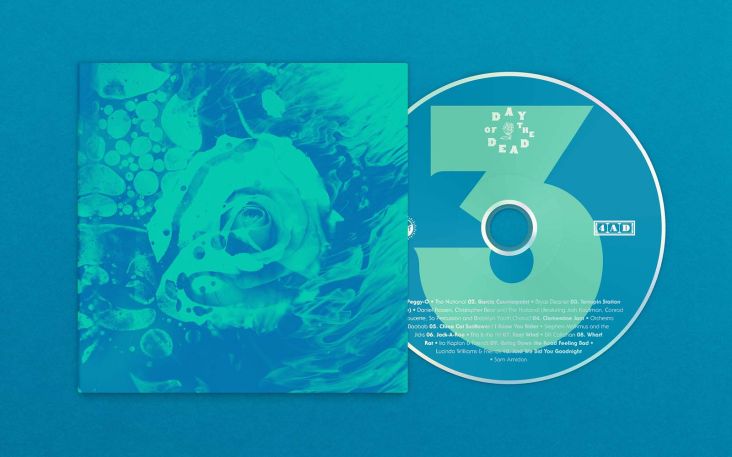Five ingenious marketing tricks to drive more people to your website
Your online shop or website's up and running and everything's where it should be. You're happy with the content. And you've carried out a few usability tests to see if visitors like what they see and convert into customers. All is good.

Image licensed via Adobe Stock
Now you'll want to look at driving more traffic. Because what's the point in having an online shop window to your business, if no one knows it exists?
Whether you're trying to attract more shoppers who might want to buy your handmade products, or you're hoping to land your next freelance project – we've teamed up with Squarespace to put together this valuable guide. (If you haven't sorted a website yet, go to Squarespace and use the CREATIVEBOOM code to get a 10% discount.)
As part of a month-long series to help you build an impressive web presence, the following tips will help you get to grips with blogging and content marketing, discover the benefits of public relations and building relationships with key influencers, and ensuring people keep coming back for more.
1. Produce lots of juicy content
If you don't want to forever rely on Google AdWords to drive traffic, then you're going to have to start building your content. Because every new blog post you publish on your site is essentially adding to your long-tail keywords, enhancing the strength of your site overall and therefore boosting organic traffic.
Have I lost you? Well, consider this: how do people search for things on Google? They often type questions, don't they! If you typed 'How do I drive more traffic to my website?' and landed on Creative Boom, then you can start to understand how each blog post might work.
Allow me to explain further. Take your home page. You know that you're trying to attract people for your site's main keyword, e.g. 'Freelance Designer Bristol'. But what about your blog posts? If each of those is a separate web page, how do you optimise each one so that they might drive traffic?
When you start to consider the bigger picture, you can understand how both humans and search engines might find your website through blog content, and how lucrative that might be.
What's more, Google places more importance on websites that are regularly updated, have more relevant content related to its main keyword or theme, and have more web visitors. So the more you blog, the more traffic you attract and the more Google sees you as necessary, thus rewarding you with better rankings in its listings. It's a win-win situation.
Find great things to blog about
Not sure where to begin? There are plenty of things you can write about – the key thing to remember is to stick to your theme, and produce content that people will want to read. If you're struggling for ideas, the following sources can help inspire your next blog post:
Twitter continues to be one of the best free resources for discovering trending topics and carving our your content plan. See what people are talking about the most and consider how you can write about it. Are there any common problems you can help address? Or interesting news stories that you could jump on?
Buzzsumo allows you to analyse what content performs best for any topic or competitor. Just enter the subject or domain, and Buzzsumo will show you what's popular. It's super helpful for when you want to understand what's working elsewhere.
Reddit will often reveal what people are talking about or questioning right now – giving you a fascinating insight into what's topical. An excellent tool for when you want to tap into current trends.
Google Trends is another excellent free resource to help you understand what people are interested in, allowing you to piggyback on leading stories and draft related content.
Hacker News isn't just for the tech community; it's a website that provides valuable insight into what people are reading right now. It's a website where its members 'vote up' content that interests them — a must for staying ahead of the curve.
Google on its own can offer a few great ideas for fresh content. Just start typing a question that you think your audience might want to learn more about, and you'll discover plenty of accessible content on the very subject. What are people finding valuable? Can you add something to the conversation? Or has the topic been done to death, and it's time to find a new angle? Google will help you craft the right theme.
Create an editorial calendar
Don't just rely on the above sources for content ideas; create an editorial calendar that will help you plan. This is especially useful if you rely on the seasons. For example, with Valentine's Day nearly upon us – you should have prepared content to market relevant products or services.
There are also lots of annual events that you can get involved with, such as Small Business Saturday or National Freelancers Day.
Or what about the key events and exhibitions that your target audience might find valuable? For example, if you work in the interiors sector – you should be aware of Sleep, Clerkenwell Design Week, London Design Festival, Maison&Objet, Salon del Mobile, and many more. These all pose opportunities to create and share content that others may find valuable.
How will you organise your calendar? Excel spreadsheets are perfectly acceptable. Or you could use any of the following to get organised:
Trello: Trello isn't just an awesome free tool to help you organise tasks; it can also be used as a calendar – one that you can easily update and adjust to suit your workflow.
Todoist: Another simple task manager that can easily be used as an editorial calendar. And it's free. Unless you want to access 'premium' features such as 'Reminders' and 'Labels & Filters'.
DivvyHQ: Come up with ideas, plan, produce and publish – in a nutshell, that's what DivvyHQ promises. And if you've got a team, you can collaborate on your content schedules. It might be overkill for what you need, but it might be something you need in future when you get bigger.
Content DJ: Kill two birds with one stone and schedule and share content across your social media channels with this neat solution that includes a powerful editorial calendar to boot. You can start with a free trial, and then upgrade from $49 per month.
For further tips, check out Buffer's complete guide to choosing a content calendar.
Craft your blog post title
Now that you've determined what you're going to write, it's time to consider the overriding theme of your blog post and what its title might look like. There are various winning formulas you can use; here are just some of them:
How-to: Quite simply, this type of headline suggests how to solve a problem and the benefit it will bring. For example, 'How to beat the competition and win more freelance work'.
List: Lists are as popular as ever on the web. To craft your own, create a heading that follows this format: [Number] + [Adjective] + [What it is] + [Benefit]. So, for example, '10 incredible solutions to help you win more freelance work'.
Story: Business is about people, and people will always want to hear the real stories behind a brand. Add some emotion to your content and share how you've overcome problems or discovered ways to improve. Use the format: 'How I solved/tackled/got from here to there', and you'll win over people's hearts and minds.
Controversial: Can you write something that's controversial and opposes the mainstream view? Speaking your mind can be risky, but there are ways to attract the right kind of attention. Some might call it 'click-bait'; I think it's clever self-marketing. For instance, could a post entitled 'Why digital marketing can be a waste of time' encourage more people to click? Turn people's expectations upside down and spark their curiosity to discover more.
Review: Are there any products or services that you could write about? Anything that you've tried and tested that others might find valuable? People are always searching for things online. Consider what your audience might look for, and do all the hard work for them.
Write the main content
With the topic and headline confirmed, it's time to start typing. But wait – where to begin? My advice is to create a structure – one that will help you stay on topic and keep the reader interested. With a clear format in place, you'll soon get into the flow. Just remember to divide your post into easy-to-digest chunks, and arrange the content as though there are chapters, just like in a book. Use the following guide:
Write a compelling intro: Grab the attention of your reader and leave them wanting more. Add an air of mystery and spark their curiosity. Easier said than done, but if you're writing a 'how-to' or advice piece, you'll most certainly be offering support on a particular issue – so tap into this immediately. For example, if you're solving a marketing problem – talk directly about that... 'Are you struggling to find more customers? Not sure why people aren't finding your website? The following tips and tricks will help'. You get the picture.
Make text readable: From a visual point of view, break up the text with paragraphs, bullet-point lists, imagery, videos and pull quotes. You don't want to overwhelm your audience with huge blocks of text; you want to add visual interest to keep people hooked and wanting to read more.
Keep referring back to the headline: It's easy to go off on a tangent, and waffle about this and that. Keep focused and relevant by referring back to the headline. What problem are you trying to solve? Stick to that, and you'll keep your audience engaged throughout.
Always consider the reader: When crafting each blog post, always have your target audience in mind. If it helps, why not create customer personas to help you develop a 'voice' that will appeal to those you're trying to win over? HubSpot has some useful advice on creating buyer personas.
Further advice can be found through our useful tips on constructing the perfect blog post. Happy blogging!
2. Share your content on social media
You've put together a content strategy for your website's blog to boost your organic traffic. You're writing excellent copy, relevant to your audience and what you do. Now it's time to share it with the world. This is where social media becomes one of the best drivers of traffic, as you'll be able to encourage people to click on anything you might share.
Make use of automation
Let's be honest. Who has time for social media? As a hardworking creative, you'll already be struggling for time without having to worry about marketing your content via Twitter and Facebook. This is where automation tools help. It's not cheating. And we're not recommending you rely on robots alone. But the following setup will keep you active when you're busy tackling projects or out at meetings:
Buffer: Buffer is a beautiful app for desktop and mobile that lets you connect Twitter, Facebook, Google+, Instagram and LinkedIn and then create queues of content that get sent at the times and days of your choosing. There’s even a super powerful Buffer browser extension so that you can share and queue content directly from other websites. This also has a particularly important function where you can click on any image within a web page and Buffer will include that in the update you wish to share or schedule.
SproutSocial: Similar to Buffer, we recommend SproutSocial for all the things that Buffer doesn’t yet provide, like the ability to track the conversation, follow and respond to people, and pretty much have everything all in one place. Much like Buffer, SproutSocial allows you to connect Twitter, Facebook, Google+ and LinkedIn, and schedule updates by choosing your times or you can make use of its ViralPost feature, where it will post optimally based on analytics. Just add your content to the schedule, and everything will automatically get published. There’s also a SproutSocial browser extension where you can schedule content that you discover while browsing the web. And we particularly love the ‘Feeds’ aspect of the software, as it allows you to connect your Feedly account and find great content to share what’s relevant to your audience.
IFTTT: This superb automation tool stands for If This, Then That and allows you to create recipes that connect apps, sparking some action. For example, you can hook your blog’s RSS feed up to your Twitter account, so that every time you post something new – IFTTT is alerted and automatically shares to Twitter. There are hundreds of ready-to-use recipes to choose from, and you can create and share your own. We recommend IFTTT’s collection of 40 recipes to streamline your social media to get started.
Bitly: This isn’t just a beneficial URL shortening service, it gives you complete ownership of all your links, allowing you to capture data and track the effectiveness of your tweets and updates. Even better, it also stops people from knowing where you’re automating your social media activity because you don’t want people to see ‘Buffer’ or ‘IFTTT’ in your updates. That would be giving the game away.
And if you're worried about when to post social updates at the best times, then some of the above tools (SproutSocial, for example) can analyse the best times and schedule things automatically for you. Or, if you prefer to schedule stuff yourself, then read this advice by AddThis – who have analysed the best times for you.
For further tips on this subject and much more, check out our complete guide to social media automation.
Supplement automation with manual input
Nothing beats good old human interaction. You know, the real stuff. Dedicate a little time every day to respond to any messages, and share other people's content that you feel would get you brownie points and also benefit your audience.
Don't, whatever you do, rely on tools to automate things like 'following' or 'liking'. You run the risk of appearing spammy and putting people off. What you can automate is your own content. Content is critical to your strategy because there’s no point in being on social media if you haven’t got anything meaningful to share. Yes, you can engage with others in conversation, but the whole point of being socially active is that you draw people to your website and brand.
And what’s great about most content is that it can be automated – i.e. updates from your own blog or other social channels – and curated content from elsewhere, things that your audience might find useful.
Repurpose old content that performed well
Buffer is great for telling you which content attracted the most clicks. And it will allow you to 'Re-Buffer' former updates, quickly re-adding them to your queue. It's a superb tool when you're pushed for time. However, a word of warning – don't keep pushing out the same old tweets or updates; people will soon get tired of it. Imagine content is like food; it has a shelf life, so avoid over-sharing it.
Analyse what isn't working and tweak
If some content is letting you down, consider tweaking the headlines – not on the original posts; just on the social updates. You may find a catchier title will achieve more clicks. And if that doesn't work, perhaps it's time to review the editorial calendar and avoid repeating said topic in future.
3. Extend your reach through PR
You've tackled your blog, and you're in charge of your social media channels. Now it's time to extend your marketing efforts to PR. This is where you start reaching out to journalists, editors and influencers, in the hope that they will talk about your business.
Approach magazines and blogs that your target audience reads
Have you got anything that may be of interest? Have you won an award? Released a new product? Launched an exciting project? Is it something that you think journalists or bloggers might be keen to cover? Do a little research to find out what they usually write about, and see if you have similar news. When you approach people, make sure you consider the following dos and don'ts:
Don't send out a generic email, hoping someone will bite. It will be evident that you didn't make an effort to get to know them or their newspaper, magazine or blog, and your 'spam' will be sent straight to trash.
Do personalise each email to the journalist or influencer in question. Find out what they want or need. Have they any submission guidelines that you can follow? By doing your research, you'll stand more of a chance of success.
Don't chase and chase – you'll become a nuisance. But if you want to find out if people are opening your emails, then use a tool such as Yesware to track and see if you can try again.
Do read the blog or magazine cover to cover, and try and spot opportunities where you could get featured. For instance, do they have an interview section? Is there a regular feature that you think you'd be perfect for? Pitch yourself – you've got nothing to lose.
Don't give up if you're having no success. PR is difficult. I should know, I do it for a living. But with persistence and patience, you will find a way to break through the competition and get yourself heard.
For further guidance, check out our guide on how to get your work featured on 45 key art and design blogs.
4. Make the most of other networks
You've got your website, so why would you need to be on any network? By creating profiles on sites such as Behance, Dribbble, Cargo, DeviantArt, 500px, Etsy or any similar community, you're extending your reach to a much wider audience.
Yes, you might be lost amongst heaps of other creatives; but the more time you spend on sharing your work and reaching out to the community – the more chance you'll be discovered and thus drive traffic to your website.
What's more, journalists and bloggers are continually scouring these networks to discover new talent to share with their readers. With this in mind, make sure you provide lots of information on all your projects and make it clear if you're happy for media to lift and share your work on their channels.
5. Learn the secrets of user retention
Now you've done all the hard work and attracted people to your website or online shop; it's time to keep them hooked and coming back for more. Because one visit alone might not result in a sale. The following ideas will get them to revisit:
Use email marketing
One of the easiest ways to stay in touch with an engaged audience is through email marketing. This is where you should start pointing visitors to your mailing list, where they can subscribe and keep updated with what you're doing (and it's a great way to share all that content you've been producing). Fire out a weekly newsletter, and you're not just maintaining your brand awareness; you're also driving more traffic back to your website.
We use Mailchimp for all our e-marketing and have had no complaints so far. We especially love its useful tips on subject line comparison and its insights into Send Time Optimisation.
As Mailchimp states: "In general, it’s most optimal to send to most subscribers on a weekday. Sunday is the best day to send to the fewest number of subscribers, while Monday through Friday is all quite similar in terms of the percentage of email addresses that have that day as optimal."
Get savvy with retargeting advertising
Not yet taken advantage of retargeting advertising? Yes, it's creepy. But if someone has visited your website and they didn't make a purchase or enquiry, then you need to remind them that you still exist and encourage them to return. Facebook, for example, allows you to retarget your web traffic through its Adverts Manager – so you can quickly fire out campaigns to those who have already found you. It even lets you target those signed up to your mailing list (Mailchimp integrates nicely if you're interested).
Promote old content on social media
Give popular blog posts a paid 'boost' on Facebook to reach new audiences. (Did you know you can target those who subscribe to your Mailchimp mailing list if their email address is the same as the one attached to their Facebook account – yep, creepy!) And do the same with Twitter. A tad more expensive, but it can be very targeted. It's just another option if you're trying to bring back traffic.
Check over and optimise old content
Google loves websites where everything appears to be in order (orange sherbet anyone?). No broken links, no weird redirects and images that still work. In which case, carry out an SEO audit of your content to see which web pages need fixing.
You should also look at your analytics to discover the popular blog posts that are still attracting traffic. Is there anything you could add to boost the ranking of each piece of content? Could you add more images? More relevant keywords? Check out Moz as a great starting point.
Write for other blogs and leave valuable comments
One final trick to mention is guest blogging. Pitch yourself and your writing talents to high traffic blogs that are relevant to your creative field, and you might find you remind former web visitors that you exist. It's all about building your brand and telling people that you exist and are doing great things.
Haven’t built your website yet? It’s super-easy with Squarespace. Remember to use the CREATIVEBOOM code, and you'll get a 10% discount. In the meantime, stay tuned for further tips next week!










](https://www.creativeboom.com/upload/articles/86/862919952c0ad18439004228895a431dc6e45ffc_732.jpg)





](https://www.creativeboom.com/upload/articles/20/20fa6864e385c951bd8e2c857062f91971d8c9ff_732.jpeg)
](https://www.creativeboom.com/upload/articles/f5/f53946a7aa1cb8a87d2b613f09ed0e7cfb7d6949_732.jpeg)





